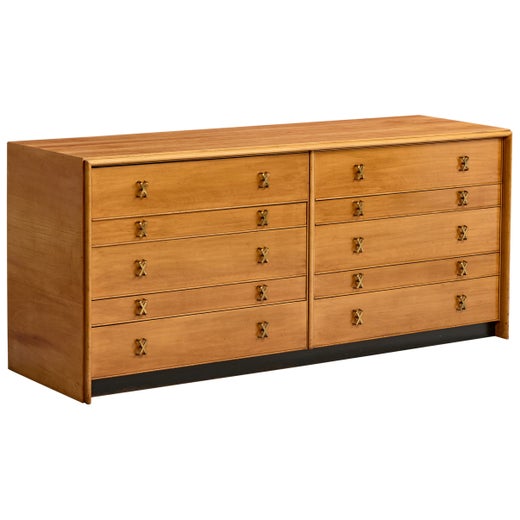Machine Age Art Deco Paul Frankl Streamline Celluloid Rond Covered Vanity Box
About the Item
- Creator:Celluloid Corporation of America (Manufacturer),Paul Frankl (Designer)
- Dimensions:Height: 2.5 in (6.35 cm)Diameter: 5.5 in (13.97 cm)
- Style:Art Deco (Of the Period)
- Materials and Techniques:
- Place of Origin:
- Period:
- Date of Manufacture:circa 1929
- Condition:Wear consistent with age and use. Minor structural damages. slight minor age warp to lid. one small stain on base, as pictured.
- Seller Location:Dallas, TX
- Reference Number:1stDibs: LU945214921441
Paul Frankl
Born in Vienna, Paul Frankl came to the United States in 1914 as part of a wave of Central European design luminaries — among them Kem Weber, Rudolph Schindler, and Richard Neutra — who were drawn by the energy and optimism of the American scene. Prolific and protean, Frankl would go on to design furnishings that are emblematic of nearly every key stylistic chord in American modernism, from the streamlined Art Deco to free-form organic shapes.
Frankl's Skyscraper cabinets, bookcases and more — introduced in 1924 — are his earliest and best-known designs (and the work by which he is most often represented in institutions, such as New York’s Metropolitan Museum of Art). Tall and narrow, the pieces have staggered shelves meant to mimic the setbacks of Manhattan office towers. A later visually expressive line — the Speed chairs and sofas, which have a raked profile suggesting motion — links Frankl to Donald Deskey, Raymond Loewy and other creators of Streamline Moderne design.
Frankl moved to Los Angeles in 1934 and luxuriated in the climate and lifestyle. His designs became lighter and simpler and found an audience among the Hollywood élite. (Katharine Hepburn, Cary Grant and Fred Astaire were clients.) Fascinated by Asian arts, Frankl produced numerous pieces — tabletops with edges that curve upward; sofas, chairs and other seating with rattan frames — inspired by Chinese and Japanese forms and materials. In the 1940s, Frankl became one of the first designers to incorporate free-form, biomorphic shapes in his work, as well as novel upholstery fabrics such as denim and nubby wool.
Frankl biographer Christopher Long argues that the designer’s easy, elegant aesthetic had an enormous influence on movie set design. As the furniture below attests, Paul Frankl’s work is ready for its close-up.
Find vintage Paul Frankl tables, dining chairs, case pieces and storage cabinets on 1stDibs.
You May Also Like
Vintage 1930s French Art Deco Jewelry Boxes
Bakelite
Mid-20th Century English Art Deco Decorative Boxes
Cotton, Walnut
Vintage 1930s American Art Deco Decorative Boxes
Brass, Copper
Mid-20th Century European Art Deco Jars
Porcelain
Vintage 1930s Austrian Art Deco Decorative Boxes
Art Glass
Vintage 1930s Austrian Art Deco Decorative Boxes
Art Glass
Vintage 1920s French Art Deco Jewelry Boxes
Coral, Gold, Enamel
Early 20th Century Austrian Art Nouveau Decorative Boxes
Wood, Burl
Early 20th Century English Art Deco Decorative Boxes
Shagreen, Wood
Early 20th Century English Art Deco Decorative Boxes
Bone, Shagreen, Wood
